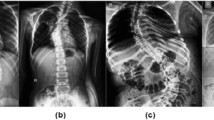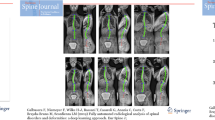Abstract
We propose a new technique for automatic spinal deformity detection from moire topographic images. Normally the moire stripes of a human body show a symmetric pattern. According to the progress of the deformity of a spine, asymmetry becomes larger. Numerical representation of the degree of asymmetry is therefore useful in evaluating the deformity. Displacement of local centroids and difference of gray value are calculated between the left-hand side and the right-hand side regions of the moire images with respect to the extracted middle line. Extracted 4 feature vectors (mean value and standard deviation from the each displacement) from the left-hand side and right-hand side rectangle areas apply to train a neural network. An experiment was performed employing 1,200 real moire images and 90.3% of the images were classified correctly.
Preview
Unable to display preview. Download preview PDF.
Similar content being viewed by others
References
Ohtsuka, Y., Shinoto, A., Inoue, S.: Mass school screening for early detection of scoliosis by use of moire topography camera and low dose X-ray imaging. Clinical Orthopaedic Surgery 14(10), 973–984 (1979) (in Japanese)
Takasaki, H.: Moire topography from its birth to practical application. Optics and Lasers in Engineering 3, 3–14 (1982)
Takasaki, H.: "Moire topography". Applied Optics 9(6), 1467–1472 (1970)
Idesawa, M., Yatagai, T., Soma, T.: Scanning moire method and automatic measurement of 3-D shapes. Applied Optics 16, 2152–2162 (1977)
Batouche, M.: A knowledge based system for diagnosing spinal deformations: Moire pattern analysis and interpretation. In: Proc. 11 Int. Conf. Pattern Recogn., pp. 591–594 (1992)
Adair, I.V., Wijk, M.C., Armstrong, G.W.D.: Moire topography in scoliosis screening. Clin. Orthop. 129, 165 (1977)
Wilner, S.: Moire topography for the diagnosis and documentation of scoliosis. Acta Orthop. Scand. 50, 295 (1979)
Roger, R.E., Stokes, I.E., et al.: Monitoring adolescent idiopathic scoliosis with moire fringe photography. Engineering in Medicine 8, 119 (1979)
Ishikawa, S., Takagami, S., Kato, K., Ohtsuka, Y.: Analyzing deformity of human backs based on the 3-D topographic reconstruction from moire images. In: Proc. 1995 Korea Automat. Control Conf., pp. 244–247 (1995)
Minovic, P., Ishikawa, S., Kato, K.: Symmetry identification of a 3-D object represented by octree. IEEE Trans. Patt. Anal. Machine Intell., PAMI 15(5), 507–514 (1993)
Ishikawa, S., Kosaka, H., Kato, K., Ohtsuka, Y.: A method of analyzing a shape with potential symmetry and its application to detecting spinal deformity. In: Comput. Vision, Virtual Reality, Robotics in Med., pp. 465–470. Springer, Heidelberg (1995)
Kim, H., Ishikawa, J.K., Otsuka, Y., et al.: Spinal deformity detection based on the evaluation of middle line’s displacement on a moire image of a human back. In: Proceedings of the International conference on control, automation and systems, pp. 818–821 (2001)
Author information
Authors and Affiliations
Editor information
Editors and Affiliations
Rights and permissions
Copyright information
© 2005 Springer-Verlag Berlin Heidelberg
About this paper
Cite this paper
Kim, H. et al. (2005). Spinal Deformity Detection Employing Back Propagation on Neural Network. In: Singh, S., Singh, M., Apte, C., Perner, P. (eds) Pattern Recognition and Image Analysis. ICAPR 2005. Lecture Notes in Computer Science, vol 3687. Springer, Berlin, Heidelberg. https://doi.org/10.1007/11552499_79
Download citation
DOI: https://doi.org/10.1007/11552499_79
Publisher Name: Springer, Berlin, Heidelberg
Print ISBN: 978-3-540-28833-6
Online ISBN: 978-3-540-31999-3
eBook Packages: Computer ScienceComputer Science (R0)




